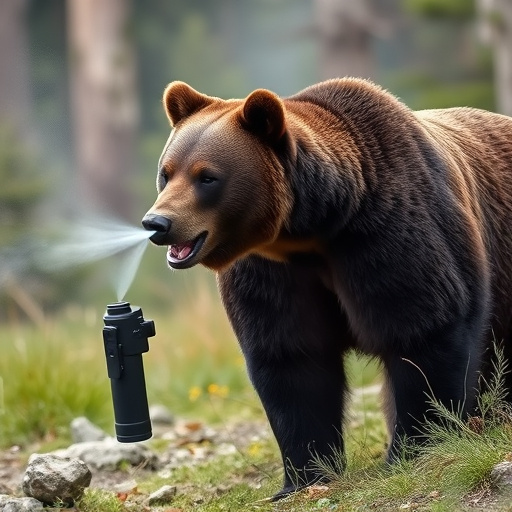Bear spray residue, effective in deterring bears, poses a complex challenge for wildlife conservation as it can cause stress and behavioral changes in non-target species. Responsible usage and disposal are crucial to protect ecosystems. Strategic use by hikers prevents bear encounters and influences wildlife habits, fostering harmony between human recreation and wild habitats. Bear spray acts as a potent repellent, disrupting bears' sense of smell up to 20 feet, minimizing risks for hikers while considering its impact on local wildlife.
“Bear repellent spray has become an essential tool for hikers navigating wilderness areas. While its effectiveness in deterring bears is well-documented, understanding the nuances of bear spray residue and its impact on wildlife is crucial. This article delves into the science behind bear spray residue, exploring how it interacts with ecosystems and affects wildlife behavior. We also weigh the critical role of bear spray in hiking safety while considering the broader ecological balance.”
- Understanding Bear Spray Residue: How It Affects Wildlife
- The Impact of Bear Repellent Spray on Hiking Safety and Ecosystem Balance
- Why Bear Spray is a Necessity for Every Hiker: A Comprehensive Guide
Understanding Bear Spray Residue: How It Affects Wildlife
Bear spray residue is a complex issue with significant implications for wildlife. When used correctly, bear repellent sprays can effectively deter aggressive bears and protect hikers in potentially dangerous situations. However, it’s crucial to understand that residual spray can persist in the environment long after application. This left-behind chemical can impact non-target species, including birds, small mammals, and fish, through ingestion or direct contact.
The impact of bear spray residue on wildlife is a growing area of concern for conservationists. Studies have shown that even low concentrations of spray components can cause physiological stress and behavioral changes in animals. These effects can range from disruptions in reproduction to alterations in feeding patterns, potentially affecting entire ecosystems. Therefore, responsible use and disposal of bear spray are essential not only for personal safety but also for preserving the well-being of wildlife populations.
The Impact of Bear Repellent Spray on Hiking Safety and Ecosystem Balance
The use of bear repellent spray has become a necessary consideration for hikers, especially in regions where bear populations are prevalent. This isn’t just about personal safety; it’s also a crucial aspect of maintaining ecosystem balance. Bear spray residue, when used appropriately, can deter bears from approaching hikers, reducing potential conflicts. However, the impact extends further than individual encounters. The presence or absence of human-disturbance behaviors, like frequent bear repellent use, can influence wildlife habits and habitat use patterns.
Studies show that responsible use of bear spray can minimize negative impacts on wildlife. It helps hikers maintain a safe distance while allowing bears to continue their natural behaviors undisturbed. By understanding the subtle cues and signals that bears use to avoid humans, hikers can contribute to the overall well-being of local ecosystems, ensuring a harmonious coexistence between human recreation and wild animal habitats.
Why Bear Spray is a Necessity for Every Hiker: A Comprehensive Guide
For hikers, navigating through nature’s labyrinthine paths is an exhilarating yet potentially risky endeavor, especially in areas where wildlife thrives. One often-overlooked essential tool that can significantly enhance safety during outdoor adventures is bear spray. This potent repellent is a game-changer when it comes to deterring bears and ensuring a safe hiking experience.
Bear spray residue creates a significant barrier, as its strong scent and capsaicin content can impact a bear’s behavior. In the event of a encounter, the spray not only repels bears but also provides crucial time for hikers to retreat or seek safety. The effectiveness of bear spray lies in its ability to reach distances of up to 20 feet, allowing users to maintain a safe distance from potential threats. Moreover, understanding how bear spray works and its impact on wildlife is essential; it disrupts a bear’s sense of smell temporarily, preventing them from tracking or approaching hikers, thus minimizing the risk of unwelcome interactions and potential attacks.
In light of the above discussions, it’s evident that bear repellent spray is not just a hiking necessity but also a tool that, when used responsibly, can balance ecosystem harmony and enhance outdoor safety. Understanding the effects of bear spray residue on wildlife and its significant role in deterring bears from human spaces is crucial. As hikers, being prepared with knowledge and the right equipment, like bear spray, ensures a more enjoyable and secure experience amidst nature’s wonders.
